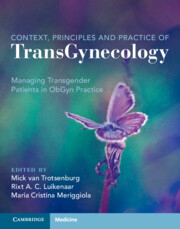Book contents
- Context, Principles, and Practice of Transgynecology
- Context, Principles, and Practice of Transgynecology
- Copyright page
- Dedication
- Contents
- Foreword
- Preface
- Contributors
- Abbreviations
- Section A Contextual Transgynecology
- Section B Practicing Transgynecology
- Section C Gynecological Surgery for Transgender Males
- Section D Sexuality and Contraception
- Section E Fertility and Reproduction
- Section F Impact of Gender-affirming Hormonal Therapy on Genital Organs
- Section G Screening and Prophylaxis
- Chapter 34 Prevention and Management of Neovaginal Stenosis and Other Related Complications of Vaginoplasty
- Chapter 35 Pelvic Physical Therapy for Gender-affirming Genital Vaginoplasty
- Chapter 36 HPV-associated Dysplasia of Skin and Mucosa and Vaccination Options in Trans People
- Chapter 37 Extent, Burden, and Characteristics of STDs and HIV in Trans People
- Chapter 38 Screening Policies for Cervical, (Neo-)Vaginal, and Vulvar Dysplasia and Cancer
- Transgynecology Index
- References
Chapter 36 - HPV-associated Dysplasia of Skin and Mucosa and Vaccination Options in Trans People
from Section G - Screening and Prophylaxis
Published online by Cambridge University Press: 22 December 2022
- Context, Principles, and Practice of Transgynecology
- Context, Principles, and Practice of Transgynecology
- Copyright page
- Dedication
- Contents
- Foreword
- Preface
- Contributors
- Abbreviations
- Section A Contextual Transgynecology
- Section B Practicing Transgynecology
- Section C Gynecological Surgery for Transgender Males
- Section D Sexuality and Contraception
- Section E Fertility and Reproduction
- Section F Impact of Gender-affirming Hormonal Therapy on Genital Organs
- Section G Screening and Prophylaxis
- Chapter 34 Prevention and Management of Neovaginal Stenosis and Other Related Complications of Vaginoplasty
- Chapter 35 Pelvic Physical Therapy for Gender-affirming Genital Vaginoplasty
- Chapter 36 HPV-associated Dysplasia of Skin and Mucosa and Vaccination Options in Trans People
- Chapter 37 Extent, Burden, and Characteristics of STDs and HIV in Trans People
- Chapter 38 Screening Policies for Cervical, (Neo-)Vaginal, and Vulvar Dysplasia and Cancer
- Transgynecology Index
- References
Summary
Human papilloma viruses (HPV) are responsible for various diseases. At least 80% of all people become infected with HPV during their lifetime. The most common transmission route is sexual contact and intense skin contact; less than 1% of all infections occur during birth via vertical transmission.
- Type
- Chapter
- Information
- Context, Principles and Practice of TransGynecologyManaging Transgender Patients in ObGyn Practice, pp. 267 - 270Publisher: Cambridge University PressPrint publication year: 2022



